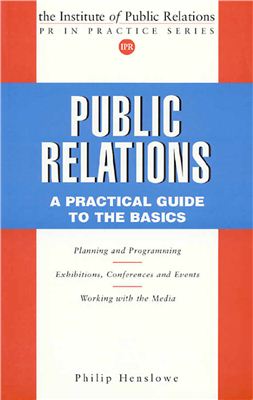Издательство Kogan Page, 1999, -161 pp.
Серия PR in Practice
So, you are absolutely new to your first job and it has something to do with public relations. Or maybe you work in an organization that hasn’t really done public relations and you.ve been asked to get on with it. The problem is, you.re not sure what to do.
Perhaps you work for a charity or voluntary organization that cannot afford a public relations professional and you need to become familiar with what’s involved. This book is for you. Philip Henslowe gives a basic introduction to public relations and introduces some very useful How tos. This isn’t a detailed guide, neither does it pretend to give any more than an overview, but as an .in. to the public relations discipline, it gives a solid base to work from.
Philip provides the legal and ethical framework of public relations practice and then goes on to indicate how those involved in public relations work with other fellow professionals who act as suppliers, photographers, printers, designers and the media (including video makers). He then goes on to describe how to organize exhibitions, displays and functions and includes a useful section on Royal visits. One of the key tasks of practitioners is of writing. Again, Philip takes the practical approach to business writing, copy and feature writing and devotes a whole section to this skill. There is also useful guidance on sponsorship, crisis management, working with the media and on planning and evaluating campaigns.
What the book does not do is cover all the functional areas of public relations such as inteal communications, marketing communications, public affairs and the like. There are plenty of books around that do this job. Philip is aiming to provide the potential practitioner with a raft of knowledge and skills that underpin the range of public relations activity.
Thus the book fulfills its brief. It is a basic guide for all who wish to work in the public relations area – whatever their future specialism may be.
The roles of public relations
Exteal public relations sources
Ethics and the law
Working with suppliers
Working with publishers
Working with printers
Working with photographers
Working with designers
Making videos
Exhibitions and other events
Promotions and functions
Visits
Sponsorship and educational activities
Business writing
Crisis management
Working with the media
New developments in technology
Planning and programming
Assessment and evaluation
Conclusion
Серия PR in Practice
So, you are absolutely new to your first job and it has something to do with public relations. Or maybe you work in an organization that hasn’t really done public relations and you.ve been asked to get on with it. The problem is, you.re not sure what to do.
Perhaps you work for a charity or voluntary organization that cannot afford a public relations professional and you need to become familiar with what’s involved. This book is for you. Philip Henslowe gives a basic introduction to public relations and introduces some very useful How tos. This isn’t a detailed guide, neither does it pretend to give any more than an overview, but as an .in. to the public relations discipline, it gives a solid base to work from.
Philip provides the legal and ethical framework of public relations practice and then goes on to indicate how those involved in public relations work with other fellow professionals who act as suppliers, photographers, printers, designers and the media (including video makers). He then goes on to describe how to organize exhibitions, displays and functions and includes a useful section on Royal visits. One of the key tasks of practitioners is of writing. Again, Philip takes the practical approach to business writing, copy and feature writing and devotes a whole section to this skill. There is also useful guidance on sponsorship, crisis management, working with the media and on planning and evaluating campaigns.
What the book does not do is cover all the functional areas of public relations such as inteal communications, marketing communications, public affairs and the like. There are plenty of books around that do this job. Philip is aiming to provide the potential practitioner with a raft of knowledge and skills that underpin the range of public relations activity.
Thus the book fulfills its brief. It is a basic guide for all who wish to work in the public relations area – whatever their future specialism may be.
The roles of public relations
Exteal public relations sources
Ethics and the law
Working with suppliers
Working with publishers
Working with printers
Working with photographers
Working with designers
Making videos
Exhibitions and other events
Promotions and functions
Visits
Sponsorship and educational activities
Business writing
Crisis management
Working with the media
New developments in technology
Planning and programming
Assessment and evaluation
Conclusion

